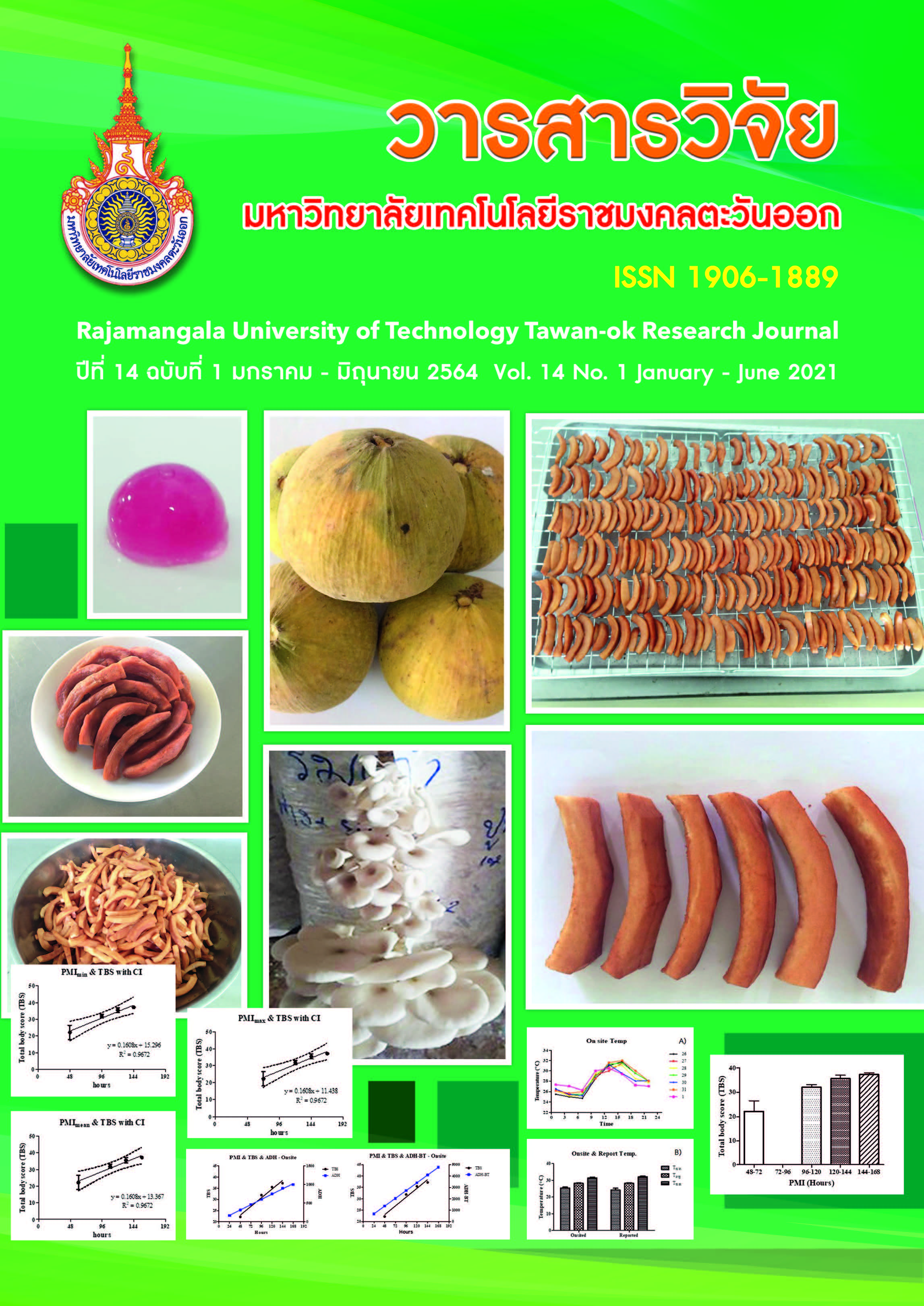Effects of Drying Temperature and Time on Product Qualities of Candied Santol
Main Article Content
Abstract
The objective of this study was to investigate effects of drying temperature and time onquality of can died Santol (Sandoricum koetjape (Burm.f.) Merr.) Product. Santol, from the same source, was first made into a candied product prior to this study. The effects of three temperature levels (50, 60 and 70 degrees Celsius) and three drying periods (8, 9 and 10 hours) were evaluated, for product quality, based on a design of 32 factorial in completely randomized design; CRD. Physico-chemical qualities, microbial content and sensory evaluation were analyzed. Results found that after drying, the interaction effect and main effect had statistically significant impact on the physical, chemical and microbial qualities of the candied santol product (p ≤ 0.05). Under conditions of 50 degrees Celsius, drying temperature, in combination with a drying time of 8 hours, the product’s physical properties
were optimized. On the other hand, under conditions of 60 degrees Celsius drying, with 8 hours of drying time, the chemical properties were optimized. Although total microbial content tended to decrease with increasing temperature, there was no effect on yeast and fungus content. No microorganism levels exceeded to microbiological properties conformed to Thai Industrial Standard Institute for fruits and vegetables 161/2015. Sensory evaluation results showed no significant different in color, flavor, and overall liking of all treatment products by panelists (n = 30) (p > 0.05). However, texture preference scored was the highest in products that were dried at 50 degrees Celsius, with the score trending to decrease as the drying temperature increased. According to food safety, this study recommends the optimal drying conditions for candied Santol drying at 60 degrees Celsius for 8 hours.
Article Details
References
A.O.A.C. 2000. Official Method of Analysis. (16th ed.), Virginia, USA. The Association of Official Analysis Chemists.
Agricultural research development agency. 2017. Formula and production process “Fruit preserve for health”. [Online] Available from https://www.nfc.or.th/content/2543#:~:text=%E2%80%. (in Thai)
Chiralt, A. and P. Talens. 2005. Physical and chemical changes induced by osmotic dehydration in plant tissues. Journal of Food Engineering. 67: 167-177.
Doymaz, I. 2010. Effect of citric acid and blanching pre-treatments on drying and rehydration of Amasya red apples. Food Bioprod. Process. 88, 124-132.
Hongwiwat, N. and T. Hongwiwat. 2007. 111 kinds of fruits : Food value and Eating. Bangkok: Sangdad. 324 pp. (in Thai)
Kong, K.W., A. Ismail, C.P. Tan. and N.F. Rajab. 2010. Optimization of oven drying conditions for lycopene content and lipophilic antioxidant capacity in a by-product of the pink guava puree industry using response surface methodology. LWT Food Sci. Technol. 43: 729-735.
Martinez-Valencia, B.B., M. Abud-Archila., M.A. Ruiz-Cabrera, A. Grajales-Lagunes, L.Dendooven, S.L.
Ovando-Chacon. and F.A. Gutierrez-Miceli. 2011. Pulsed vacuum osmotic dehydration kinetics of melon (Cucumis melo L.) var. cantaloupe. African Journal of Agricultural Research. 6 (15): 3588-3596.
Niwat, J. 1999. Drying of pineapples using continuous osmosis method. Master’s thesis. Department of Food Science, Kasetsart University, Bangkok. (in Thai)
Niyomvit, N. 1984. Treatise for Crystallized fruit. Department of Home Economics, Faculty of Agriculture Kasetsart University, Bangkok. (in Thai)
Pennington, T.D. and B.T. Styles. 1975. A generic monograph of the Meliaceae. Biodiversity, Evolution and Biogeography of Plants, 22 (3): 419-540 (in Thai).
Pornchaloempong, P. and N. Rattanapanone. 2021. Water Activity. [Online] Available from http://www.foodnetworksolution.com/wiki/word/0277/dehydration. (in Thai). [Accessed January 20,
Postharvest Technology Innovation Center. 2013. Water Activity with controlling the shelf life of food products. html: file://C:Documents and SettingsadminDesktopOToP 57Water Activity niunrrn?uF!ila1q (in Thai). Accessed 20 Jan. 2021.
Soponronnarit, S. 1997. Drying of seeds. 5th edition, Faculty of Energy and Materials, Institute of Technology King Mongkut’s University of Technology Thonburi. 338 p. (in Thai)
Sripui, J. 2003. Fruit and vegetable processing. Academic Service Centre Khon Kaen University, 11 (1): 58-64
Thai Industrial Standards Institute. 2015. Thai community product standards: dried fruits and vegetables. TCPS Number.136/2558. (in Thai)
Therdthai, N. 2008. Design in agro-industry. Department of Product Development, Faculty of Agro-Industry, Kasetsart University, Bangkok 209 pp. (in Thai)
Therdthai, N. and S. Krajangmathekul. 2011. Effect of Microwave Assisted Hot Air Drying on Quality of Dried Pumpkin. Proceedings of 49th Kasetsart University Annual Conference: Agro-Industry, Bangkok. Page 133-140.
Uan-On, T. 2003. Quality and Process Improvement of Dried Banana. Master Thesis. Department of Agro-Industrial Product Development, Kasetsart University, Bangkok. 111 pp.
Yuenyongputtakal, W., and P. Noyphan. 2010. Effects of pre-treatment and high temperature short time drying conditions on the quality of dried Banana (Musa sapientum). Agricultural Science Journal, 41(3), 229-232. (in Thai)


